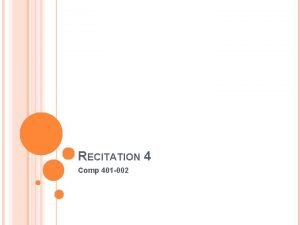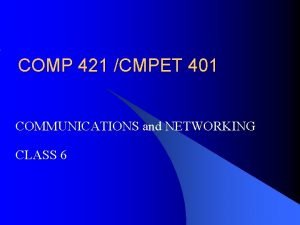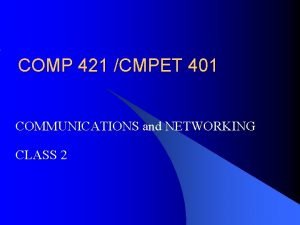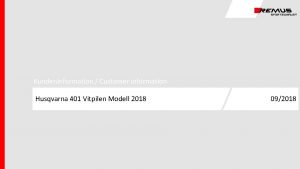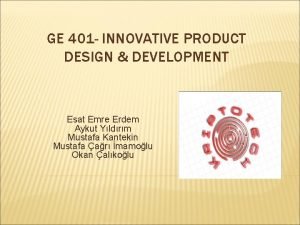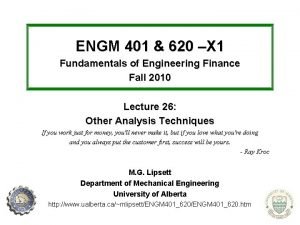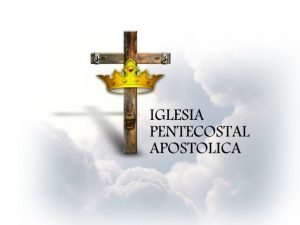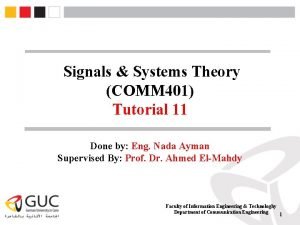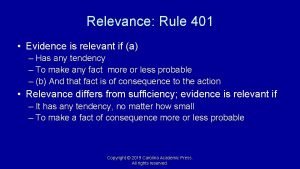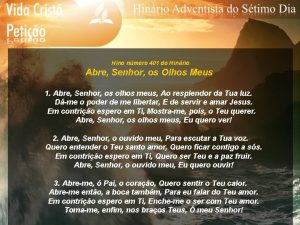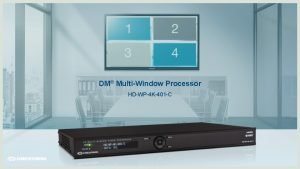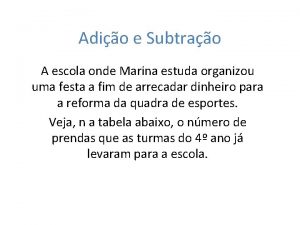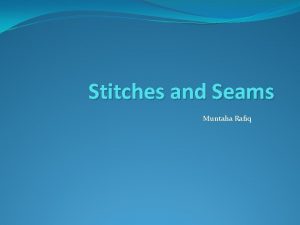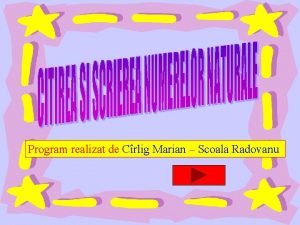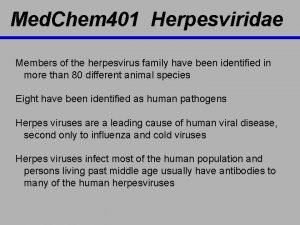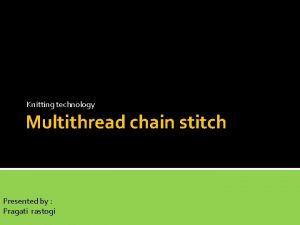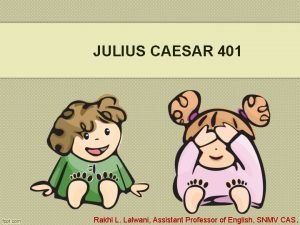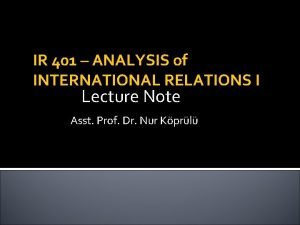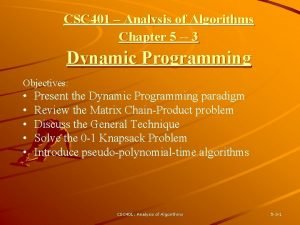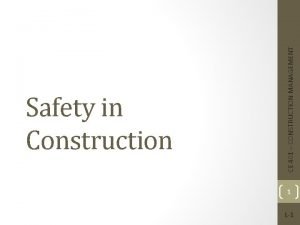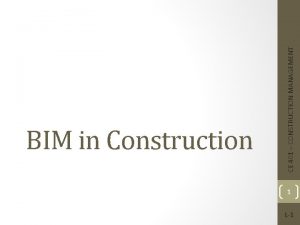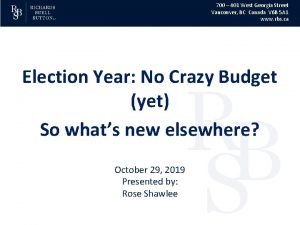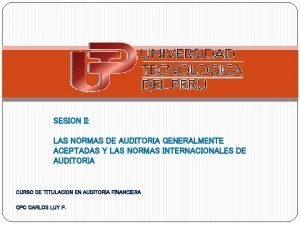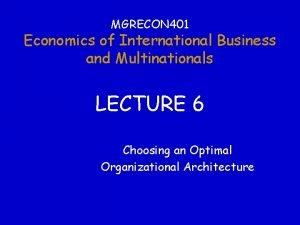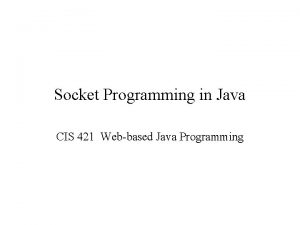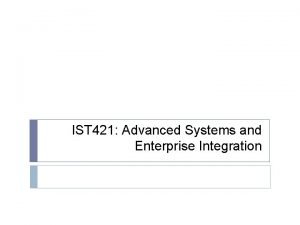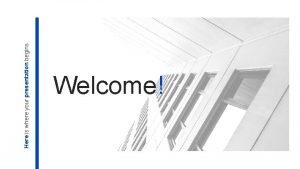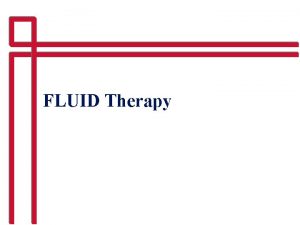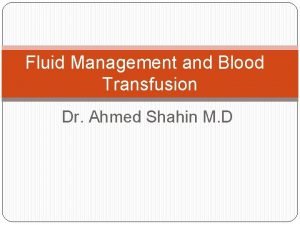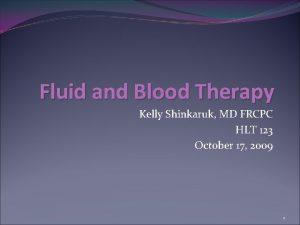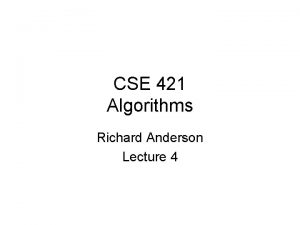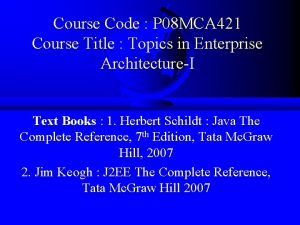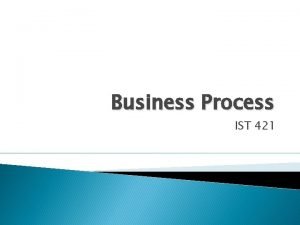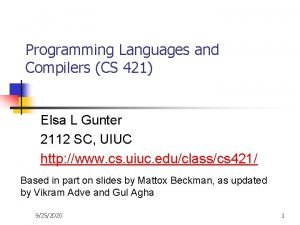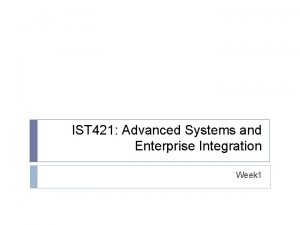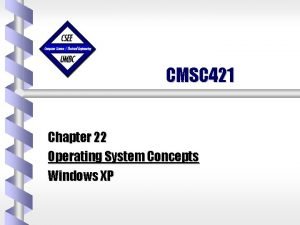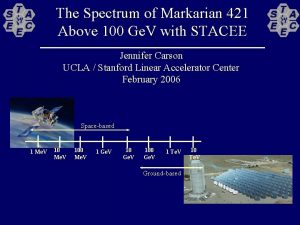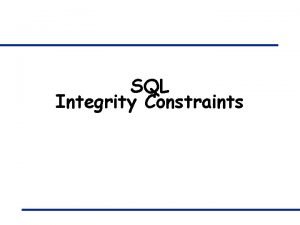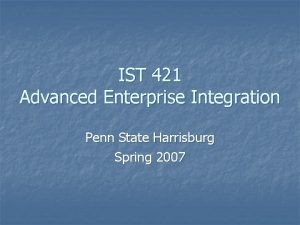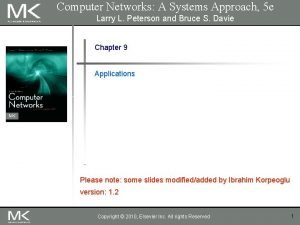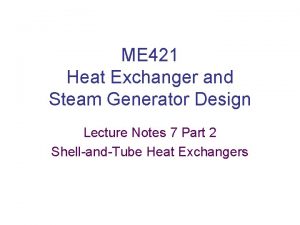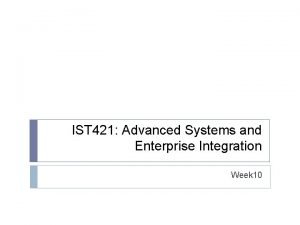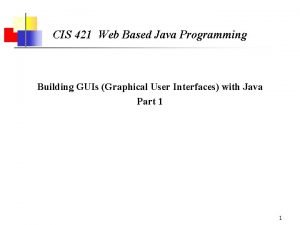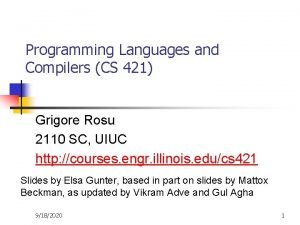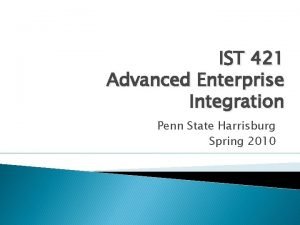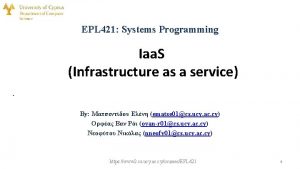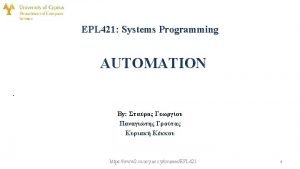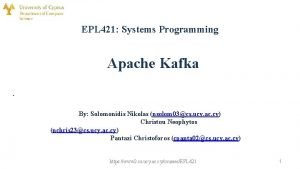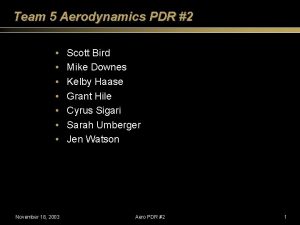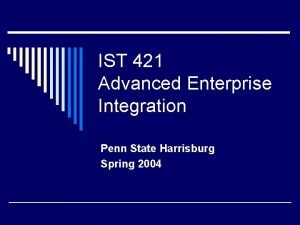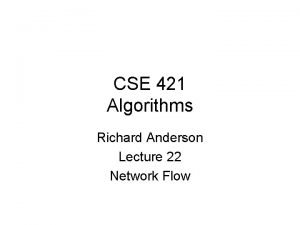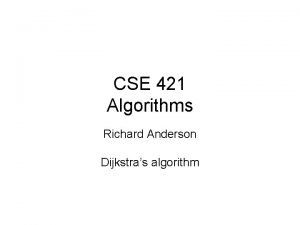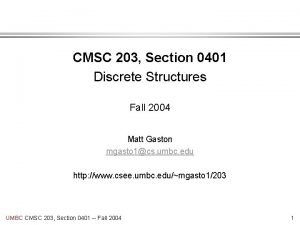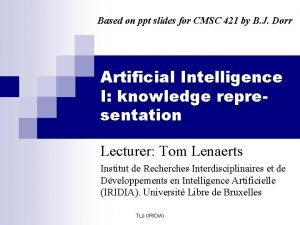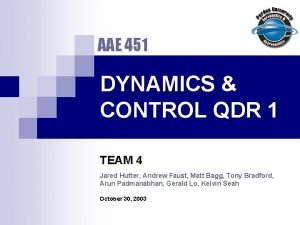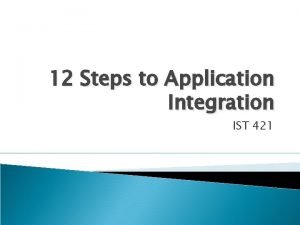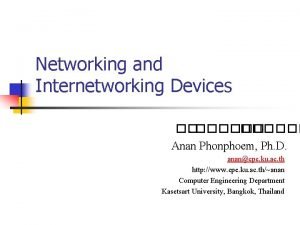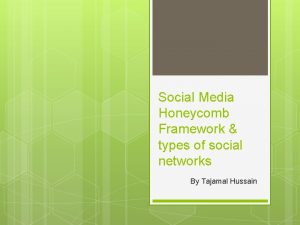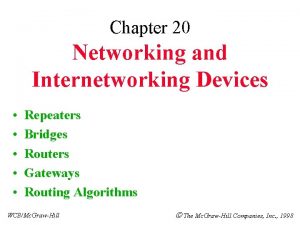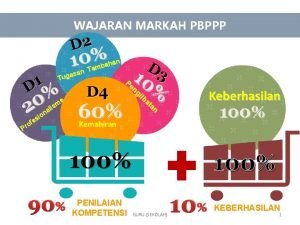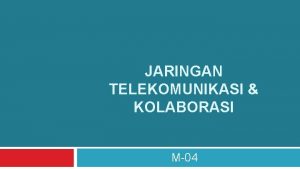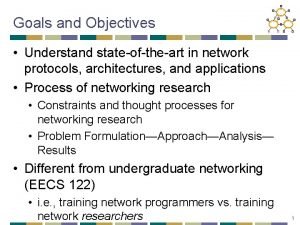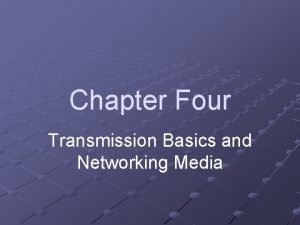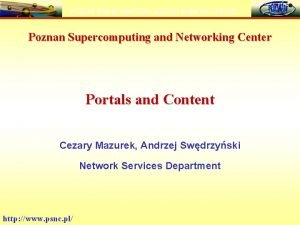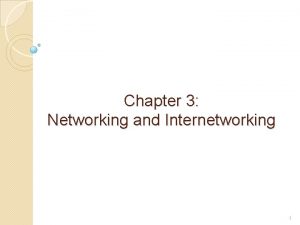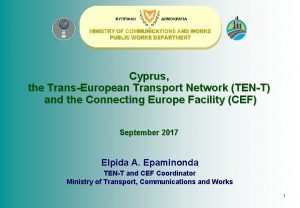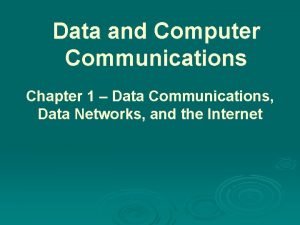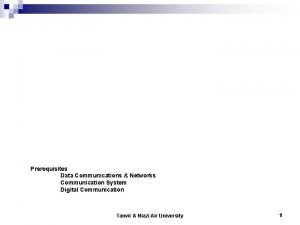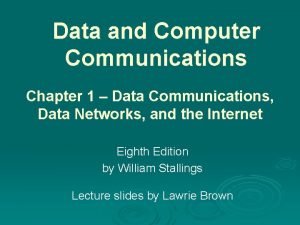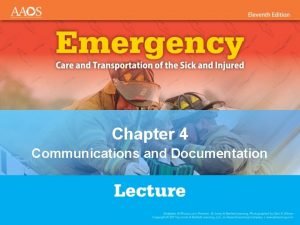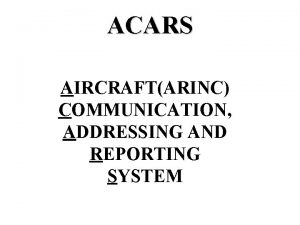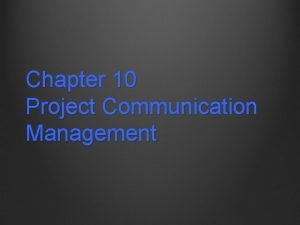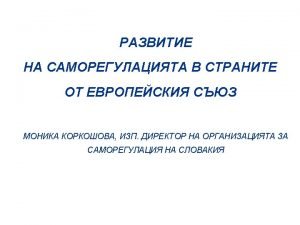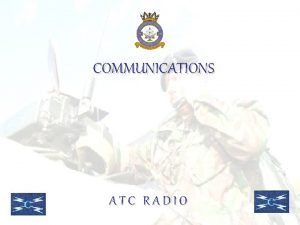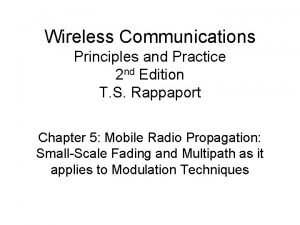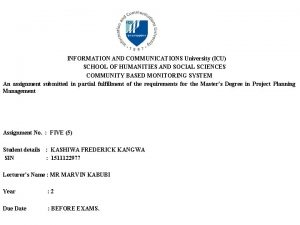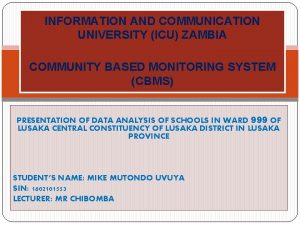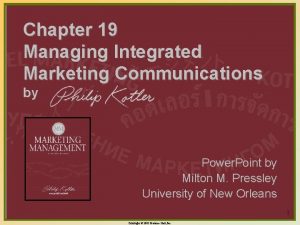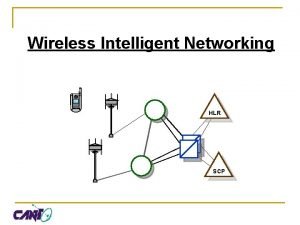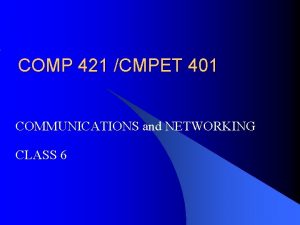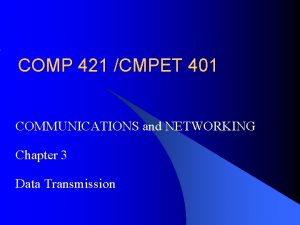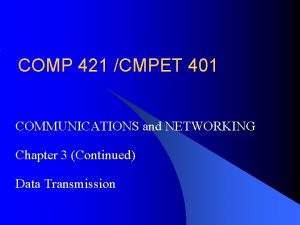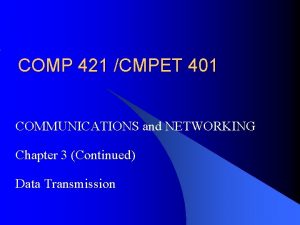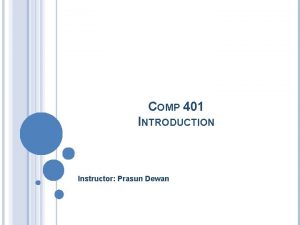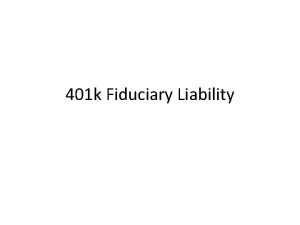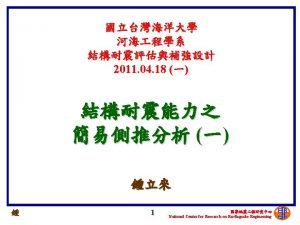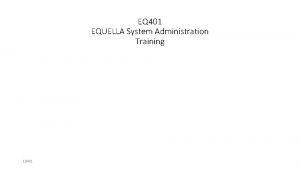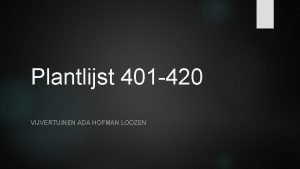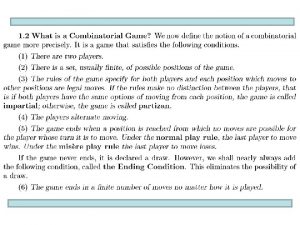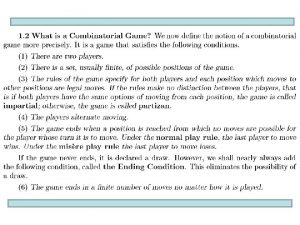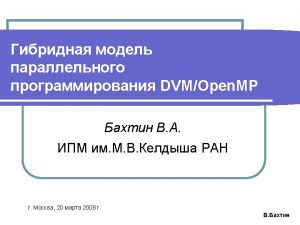COMP 421 CMPET 401 COMMUNICATIONS and NETWORKING CLASS





























































































































- Slides: 125

COMP 421 /CMPET 401 COMMUNICATIONS and NETWORKING CLASS 5 (4 B)

TRANSMISSION MEDIA

Overview Guided - wire l Unguided - wireless l Characteristics and quality determined by medium and signal l For guided, the medium is more important l For unguided, the bandwidth produced by the antenna is more important l Key concerns are data rate and distance l

Design Factors l Bandwidth – Higher bandwidth gives higher data rate l Transmission impairments – Attenuation Interference l Number of receivers l – Major factor in guided media – More receivers (multi-point) introduce more attenuation

Electromagnetic Spectrum

Guided Transmission Media l l l The transmission capacity depends on the distance and on whether the medium is point-to-point or multi-point Medium Freq Range Typical Repeater Atten. Delay Spacing Twisted Pair Coaxial cable Optical fiber – Multi-mode 0 - 3. 5 KHz 0. 2 d. B/km 50 us/km 2 km – Single Mode 180 -370 THz 0. 2 d. B/km 5 us/km 40 km 0 - 1. 0 MHz 3. 0 d. B/km 5 us/km 2 km 0 - 500 MHz 7. 0 d. B/km 4 us/km 1 -9 km 180 -370 THz 0. 5 d. B/km 5 us/km 2 km

Twisted Pair l l l Consists of two insulated copper wires arranged in a regular spiral pattern to minimize the electromagnetic interference between adjacent pairs Often used at customer facilities and also over distances to carry voice as well as data communications Low frequency transmission medium

Twisted Pair - Applications Most common medium l Telephone network l – Between house and local exchange (subscriber loop) l Within buildings – To private branch exchange (PBX) l For local area networks (LAN) – 10 Mbps or 100 Mbps

Twisted Pair - Pros and Cons l Cheap l Easy to work with l Low data rate l Short range

Twisted Pair - Transmission Characteristics l l l Analog – Amplifiers every 5 km to 6 km Digital – Use either analog or digital signals – repeater every 2 km or 3 km Limited distance Limited bandwidth (1 MHz) Limited data rate (100 MHz) using different modulation & signaling techniques Susceptible to interference and noise

Unshielded and Shielded TP l l Unshielded Twisted Pair (UTP) – Ordinary telephone wire – Cheapest – Easiest to install – Suffers from external electromagnetic interference (EM) Shielded Twisted Pair (STP) – the pair is wrapped with metallic foil or braid to insulate the pair from electromagnetic interference – More expensive – Harder to handle (thick, heavy)

UTP Categories l Cat 3 – up to 16 MHz – Voice grade found in most offices – Twist length of 7. 5 cm to 10 cm l Cat 4 (least common) – up to 20 MHz l Cat 5 – up to 100 MHz – Commonly pre-installed in new office buildings – Twist length 0. 6 cm to 0. 85 cm

Category 5 E and 6 Today, cables and related components are available in more grade categories than the industry standards specify. You can choose from Cat 5, Cat 5 e, Cat 5 e+, Cat 6 and yes, even Cat 6+. While there is plenty of hype and confusion surrounding these implied categories

CAT 6 Features Cat 6 more than doubles the bandwidth of Cat 5 e, from 100 MHz to 250 MHz, supporting future emerging applications Improved EMC performance to reject outside noise from TVs, wireless, and other adjacent applications. Full backwards compatibility to support all legacy applications Simpler and less costly installations, due to reduction in electronics needed for echo and NEXT (Near End Cross Talk) cancellation.

Equations for CAT 6 Parameters Attenuation (d. B) = 1. 991*sqrt(f) + 0. 01785*f + 0. 21/sqrt(f) pr-pr NEXT (d. B) = -20 log( 10^( -0. 05(74. 3 -15 log(f)) ) + 2*10^( -0. 05(94. 0 -20 log(f)) ) ) PSNEXT (d. B) = -20 log( 10^( -0. 05(72. 3 -15 log(f)) ) + 2*10^( -0. 05(90. 0 -20 log(f)) ) ) pr-pr FEXT (d. B) = -20 log( 10^( -0. 05(67. 8 -20 log(f)) ) + 4*10^( -0. 05(83. 1 -20 log(f)) ) ) PSFEXT (d. B) = -20 log( 10^( -0. 05(72. 3 -20 log(f)) ) + 4*10^( -0. 05(90. 0 -20 log(f)) ) ) Return loss (d. B) = 19 at 1 -20 MHz; 19 -10*log(f/20) at 20 -250 MHz Phase Delay (ns) = 546 + 34/sqrt(f) Delay skew (ns) = 50 pr-pr PS pr-pr PS return phase delay freq atten NEXT ELFEXT loss delay skew (MHz) (d. B) (d. B) (ns) 100 21. 7 39. 9 37. 1 23. 2 20. 2 12. 0 549. 4 50. 0 250 36. 0 33. 1 30. 2 17. 2 14. 2 8. 0 548. 2 50. 0

The RJ 45 Connector To identify the RJ-45 cable type, hold the two ends of the cable next to each other so you can see the colored wires inside the ends · Straight-through — the colored wires are in the same sequence at both ends of the cable. Crossover — the first (far left) colored wire at one end of the cable is the third colored wire at the other end of the cable

Understanding USOC & RJ 8 -Wire Jack (10 Base. T Data Connections) 8 -Wire Jacks (USOC RJ 31 X Through RJ 37 X) 6 -Wire Jack (USOC - RJ 14 W)

Understanding USOC & RJ 8 -Wire Jack (IBM Token Ring Connections) 8 -Wire Jacks (USOC RJ 41 Through RJ 48) Also TIA 568 B (TIA 568 A Swaps Pairs 2 & 3) 6 -Wire Jack Modified Jack (DEC MMJ)

Twisted Pair Advantages l Inexpensive and readily available l Flexible and light weight l Easy to work with and install

Twisted Pair Disadvantages l Susceptibility to interference and noise l Attenuation problem – For analog, repeaters needed every 5 -6 km – For digital, repeaters needed every 2 -3 km l Relatively low bandwidth

LEVEL 5 CABLING PER Specification TSB-36 for UTP cable connections for LEVEL 5: - A terminal jack can be 90 M (295 ft) from the wiring closet. - A device can be 10 M from a terminal jack at the users location. - There can be up to 6 M of cross-connect patch cords in the wire clo - Termination of cables must obey the following: - Twists of actual pairs must be maintained to half-inch of t - Cable sheath should be stripped only as far as necessary to - Cables bundles should not nopt tightly bound or cinched - Cable bundles should not be placed under stress or tension - Cable bend radii should not be less than 8 times the cable

Coaxial Cable

Coaxial Cable Applications Most versatile medium l Television distribution l – Aerial to TV – Cable TV l Long distance telephone transmission – Can carry 10, 000 voice calls simultaneously – Being replaced by fiber optic Short distance computer systems links l Local area networks l

Coaxial Cable - Transmission Characteristics l Analog – Amplifiers every few km – Closer if higher frequency – Up to 500 MHz l Digital – Repeater every 1 km – Closer for higher data rates

Coax The outer shield protects the inner conductor from outside electrical signals. The distance between the outer conductor (shield) and inner conductor plus the type of material used for insulating the inner conductor determine the cable properties or impedance. Typical impedances for coaxial cables are 75 ohms for Cable TV, 50 ohms for Ethernet Thinnet and Thicknet. The excellent control of the impedance characteristics of the cable allow higher data rates to be transferred than with twisted pair cable.

Coax Advantages l Higher bandwidth – 400 to 600 Mhz – up to 10, 800 voice conversations l Can be tapped easily (pros and cons) l Much less susceptible to interference than twisted pair

Coax Disadvantages l High attenuation rate makes it expensive over long distance l Bulky

CABLE SUBSITUTION DATA TYPE CM Communication wires & cables CL 2 Class 2 remote control, signaling, & power-limited cables CL 3 Class 3 remote control, signaling, & power-limited cables FPL Power limited fire protective signaling cables MP Multi-purpose cables PLTC Power limited tray cable xx. R Indicates a RISER cable xx. P Indicates a PLENUM cable Plenum is highest grade. Order is : MPP -> CMP -> CL 3 P -> CL 2 P; FPLP -> CL 3 P & 2 P Riser is next higher grade. Order is : MPR -> CMR -> CL 3 R -> CL 2 R; FPLR -> CL 3 R & CL 2 R General Purpose is next. Order is : MP -> CM -> CL 3 -> CL 2 : FPL or PLTC -> CL 3 & CL 2 Residential is lowest. The order is : CMX -> CL 3 X -> CL 2 X

THE CATEGORIES OF CABLE WIRE LEVEL 1 Level 1 cable is for basic comm & power limited circuits. VOICE GRADE ONLY. 2 Level 2 cable is similar to IBM Type 3 cable for 2 to 25 twisted pair cable. 1 MHz max. 8 db/1000 ft attenuation @ 1 MHz; 4 db/1000 ft @ 256 KHz. DIGITAL DATA GRADE 3 Level 3 cable is Unshielded Twisted Pair (typical telephone wire). 16 MHz max frequen 7. 8 db/1000 ft attenuation @ 1 MHz; 4 db/1000 ft @ 256 KHz. 10 Mpbs ENET/ 4 Mpbs TR 4 Level 4 cable is Low Loss Premises Telecommunication cable, shielded/unshielded, 20 M 6. 5 db/1000 ft attenuation @ 1 MHz; 31 db/1000 ft @ 20 MHz for 24 AWG wire 4. 5 db/1000 ft atten @ 1 MHz; 24 db/1000 ft @ 20 MHz for 22 AWG wire. 16 Mbps TR. 5 Level 5 cable is DATA GRADE up to 100 Mbit

IBM CABLE TYPE 1 Dual pair STP 22 AWG solid, non-plenum data cable, used for long runs in walls of buildings 1 P Dual pair STP 22 AWG, plenum data cable 2 Dual pair STP 22 AWG data, 4 pair UTP 24 AWG solid, telephone(voice) non-plenum cable 2 P Dual pair STP 22 AWG data, 4 pair 22 AWG telephone plenum cable 3 Multi-pair (usually 4) UTP 22 or 24 AWG solid data & voice cable for runs in walls 5 Two 100/140 micrometer optical fiber in a single sheath 6 Dual pair 26 AWG non-plenum patch panel data cable, used for patch panels. Attn=1. 5 x. Type 1 8 One flat STP of 26 AWG stranded wire for under carpet 9 Dual pair STP 26 AWG solid non-plenum data cable, Low grade dual pair. Attn=1. 5 x. Type 1 9 P Dual pair STP 26 AWG plenum data cable 9 R Dual pair STP 26 AWG riser data cable Based on general description of cable per IBM definitions

Optical Fiber

Optical Fiber - Benefits l Greater capacity – Data rates of hundreds of Gbps Smaller size & weight l Lower attenuation l Electromagnetic isolation l Greater repeater spacing l – 10 s of km at least

Attenuation

Optical Fiber - Applications Long-haul trunks l Metropolitan trunks l Rural exchange trunks l Subscriber loops l LANs l

Optical Fiber - Transmission Characteristics l l Act as wave guide for 1014 to 1015 Hz – Portions of infrared and visible spectrum Light Emitting Diode (LED) – Cheaper – Wider operating temp range – Last longer Injection Laser Diode (ILD) – More efficient – Greater data rate Wavelength Division Multiplexing

Fiber Optic Types l Multimode step-index fiber – the reflective walls of the fiber move the light pulses to the receiver l Multimode graded-index fiber – acts to refract the light toward the center of the fiber by variations in the density l Single mode fiber – the light is guided down the center of an extremely narrow core

Optical Fiber Optical fiber consists of thin glass fibers that can carry information at frequencies in the visible light spectrum and beyond. The typical optical fiber consists of a very narrow strand of glass called the core. Around the core is a concentric layer of glass called the cladding. A typical core diameter is 62. 5 microns (1 micron = 10 -6 meters). Typically Cladding has a diameter of 125 microns. Coating the cladding is a protective coating consisting of plastic, it is called the Jacket.

Refraction in Fiber An important characteristic of fiber optics is refraction. Refraction is the characteristic of a material to either pass or reflect light. When light passes through a medium, it "bends" as it passes from one medium to the other. An example of this is when we look into a pond of water.

Angle of Incidence If the angle of incidence is small, the light rays are reflected and do not pass into the water. If the angle of incident is great, light passes through the media but is bent or refracted. Optical fibers work on the principle that the core refracts the light and the cladding reflects the light. The core refracts the light and guides the light along its path. The cladding reflects any light back into the core and stops light from escaping through it - it bounds the medium!

Optical Fiber Transmission Modes

Step Index Step index has a large core, so the light rays tend to bounce around inside the core, reflecting off the cladding. This causes some rays to take a longer or shorter path through the core. Some take the direct path with hardly any reflections while others bounce back and forth taking a longer path. The result is that the light rays arrive at the receiver at different times. The signal becomes longer than the original signal. LED light sources are used. Typical Core: 62. 5 microns. Step Index Mode

Graded Index Graded index has a gradual change in the core's refractive index. This causes the light rays to be gradually bent back into the core path. This is represented by a curved reflective path in the attached drawing. The result is a better receive signal than with step index. LED light sources are used. Typical Core: 62. 5 microns. Graded Index Mode

Single Mode Single mode has separate distinct refractive indexes for the cladding and core. The light ray passes through the core with relatively few reflections off the cladding. Single mode is used for a single source of light (one color) operation. It requires a laser and the core is very small: 9 microns. Single Mode

Comparison of Optical Fibers

Loose Tube Fiber Non-armored Armored

FIBER OPTIC LINK SUMMARY

A Fiber Connector

Fiber Connectors

Splicing Technologies Splicing technologies may be divided into two basic categories: fusion and mechanical. Avg. Splice Loss (d. B) Fusion Splicing 0. 10 d. B Rotary Mechanical* 0. 20 d. B Mechanical Splice 0. 20 d. B Mechanical methods may include products that use mechanical means to align two cleaved fibers or products that require polishing of the fiber ends. Return Loss Return loss is the measure of the level of signal reflected by the splice back to the source. Return loss of 40 d. B or better is needed to assure proper performance for analog video transmission over fiber.

DWDM works by combining and transmitting multiple signals simultaneously at different wavelengths on the same fiber. In effect, one fiber is transformed into multiple virtual fibers. So, if you were to multiplex eight OC -48 signals into one fiber, you would increase the carrying capacity of that fiber from 2. 5 Gb/s to 20 Gb/s. Currently, because of DWDM, single fibers have been able to transmit data at speeds up to 400 Gb/s. And, as vendors add more channels to each fiber, terabit capacity is on its way. A key advantage to DWDM is that it's protocol and bit-rate independent. DWDM-based networks can transmit data in IP, SONET/SDH, Ethernet, and handle bit-rates between 100 Mb/s and 2. 5 Gb/s. Therefore, DWDM -based networks can carry different types of traffic at different speeds over an optical channel.

Fiber Optic Advantages l Greater capacity (bandwidth of up to 2 Gbps) l Greater distance—can run fiber as far as several kilometers. l Smaller size and lighter weight l Lower attenuation - The light signals meet little resistance, so data l Immunity to environmental interference l Highly secure due to tap difficulty and lack of signal radiation can travel farther.

Fiber Optic Disadvantages l Expensive over short distance l Requires highly skilled installers l Adding additional nodes is difficult

Fiber Testing and certifying fiber optic cable. It's easy to certify fiber optic cable because of its immunity to electrical interference. You only need to check a few measurements: Attenuation (or decibel loss)—Measured in d. B/km, this is the decrease of signal strength as it travels through the fiber optic cable. Return loss—This is the amount of light reflected from the far end of the cable back to the source. The lower the number, the better. For example, a reading of -60 d. B is better than -20 d. B. Graded refractive index—Measures how much light is sent down the fiber. This is commonly measured at wavelengths of 850 and 1300 nm. Compared to other operating frequencies, these two ranges yield the lowest intrinsic power loss. (NOTE: This is valid for multimode fiber only. ) Propagation delay—This is the time it takes for a signal to travel from one point to another over a transmission channel. Time-domain reflectometry (TDR)—Transmits high-frequency pulses so you can examine the reflections along the cable and isolate faults.

Fiber Design Considerations • Maximum 150 to 160 kilometers between repeaters • Determined by loss budget • Typical installation 60 to 80 kilometer between repeaters • 0. 25 d. B loss per kilometer for fiber • Lasers • Transmitters have output from 0 to +10 d. Bm • Receivers have -30 d. Bm average receiver sensitivity • Repeater amplifiers consume 100 watts per fiber • Under 2. 5 Gigabits/sec per fiber pair is no longer state of art

Wireless Transmission Unguided media l Transmission and reception via antenna l Two techniques are used: l Directional l – Focused beam – Careful alignment required l Omnidirectional – Signal spreads in all directions – Can be received by many antennas

Frequencies l l l 2 GHz to 40 GHz – Microwave – Highly directional – Point to point – Satellite 30 MHz to 1 GHz – Omnidirectional – Broadcast radio 3 x 1011 to 2 x 1014 – Infrared – Local

Wireless Examples Terrestrial microwave transmission l Satellite transmission l Broadcast radio l Infrared l

Troposcatter Antenna Configuration

Terrestrial Microwave l Uses the radio frequency spectrum, commonly from 2 to 40 Ghz l Transmitter is a parabolic dish, mounted as high as possible l Used by common carriers as well as by private networks l Requires unobstructed line of sight between source and receiver l Curvature of the earth requires stations (called repeaters) to be ~30 miles apart

Microwave Transmission Applications l Long-haul telecommunications service for both voice and television transmission l Short point-to-point links between buildings for closed-circuit TV or a data link between LANs

Microwave Transmission Advantages l No cabling needed between sites l Wide bandwidth l Multi-channel transmissions

Microwave Transmission Disadvantages l Line of sight requirement l Expensive towers and repeaters l Subject to interference such as passing airplanes and rain

LOS Radio

Fresnel Zones So, in a nutshell, to visualize what happens to radio waves when they encounter an obstacle, we have to develop a picture of the wavefront after the obstacle as a function of the wavefront just before it (as opposed to simply tracing rays from the distant source). Now we're in a position to talk about Fresnel zones. A Fresnel zone is a simpler concept once you have some understanding of diffraction: it is the volume of space enclosed by an ellipsoid which has the two antennas at the ends of a radio link at its foci. The surface of the ellipsoid is defined by the path ACB, which exceeds the length of the direct path AB by some fixed amount. This amount is n /2, where n is a positive integer. For the first Fresnel zone, n = 1 and the path length differs by /2 (i. e. , a 180 phase reversal with respect to the direct path). For most practical purposes, only the first Fresnel zone need be considered.

Fresnel Zone The two-dimensional representation of a Fresnel zone is In order to quantify diffraction losses, they are usually expressed in terms of a dimensionless parameter , given by: where d is the difference in lengths of the straight-line path between the endpoints of the link and the path which just touches the tip of the diffracting object (see Fig. 7, where d = d 1 + d 2 - d). By convention, is positive when the direct path is blocked (i. e. , the obstacle has positive height), and negative when the direct path has some clearance ("negative height").

Diffraction “Knife edge" diffraction means that the top of the obstacle is small in terms of wavelengths. This is sometimes a reasonable approximation of an object in the real world, but more often than not, the obstacle will be rounded (such as a hilltop) or have a large flat surface (like the top of a building), or otherwise depart from the knife edge assumption. In such cases, the path loss for the grazing case can be considerably more than 6 d. B - in fact, 20 d. B would be a better estimate in many cases. So, Fresnel zone clearance can be pretty important on real-world paths. And, again, keep in mind that the Fresnel zone is three-dimensional, so clearance must also be maintained from the sides of buildings, etc. if path loss is to be minimized. Another point to consider is the effect on Fresnel zone clearance of changes in atmospheric refraction, as discussed in the last section. We may have adequate clearance on a longer path under normal conditions (i. e. , 4/3 earth radius)

Ground Reflections One common source of reflections is the ground. It tends to be more of a factor on paths in rural areas; in urban settings, the ground reflection path will often be blocked by the clutter of buildings, trees, etc. In paths over relatively smooth ground or bodies of water, however, ground reflections can be a major determinant of path loss. For any radio link, it is worthwhile to look at the path profile and see if the ground reflection has the potential to be significant. It should also be kept in mind that the reflection point is not at the midpoint of the path unless the antennas are at the same height and the ground is not sloped in the reflection region - just the remember the old maxim from optics that the angle of incidence equals the angle of reflection

Other Sources of Reflections On long links, reflections from objects near the line of the direct path will almost always cause increased path loss - in essence, you have a permanent "flat fade" over a very wide bandwidth. Reflections from objects which are well off to the side of the direct path are a different story, however. This is a frequent occurrence in urban areas, where the sides of buildings can cause strong reflections. In such cases, the angle of incidence may be much larger than zero, unlike the ground reflection case. This means that horizontal and vertical polarization may behave quite differently When the reflecting surface is vertical, like the side of a building, a signal which is transmitted with horizontal polarization effectively has vertical polarization as far as the reflection is concerned. Therefore, horizontal polarization will generally result in weaker reflections and less multipath than vertical polarization in these cases.

Effects of Rain, Snow and Fog The loss of LOS paths may sometimes be affected by weather conditions (other than the refraction effects which have already been mentioned). Rain and fog (clouds) become a significant source of attenuation only when we get well into the microwave region. Attenuation from fog only becomes noticeable (i. e. , attenuation of the order of 1 d. B or more) above about 30 GHz. Snow is in this category as well. Rain attenuation becomes significant at around 10 GHz, where a heavy rainfall may cause additional path loss of the order of 1 d. B/km.

Attenuation from Trees and Forests Trees can be a significant source of path loss, and there a number of variables involved, such as the specific type of tree, whether it is wet or dry, and in the case of deciduous trees, whether the leaves are present or not. Isolated trees are not usually a major problem, but a dense forest is another story. The attenuation depends on the distance the signal must penetrate through the forest, and it increases with frequency. According to a CCIR report [10], the attenuation is of the order of 0. 05 d. B/m at 200 MHz, 0. 1 d. B/m at 500 MHz, 0. 2 d. B/m at 1 GHz, 0. 3 d. B/m at 2 GHz and 0. 4 d. B/m at 3 GHz. At lower frequencies, the attenuation is somewhat lower for horizontal polarization than for vertical, but the difference disappears above about 1 GHz. This adds up to a lot of excess path loss if your signal must penetrate several hundred meters of forest! Fortunately, there is also significant propagation by diffraction over the treetops, especially if you can get your antennas up near treetop level or keep them a good distance from the edge of the forest, so all is not lost if you live near a forest

Link Analysis

Some PDH to SDH Comparisons PDH SDH (Plesiochronous Digital Hierarchy) • SDH (Synchronous Digital Hierarchy) Asynchronous Bit Interleaving - Requires Complete Demux of Data Stream to Extract a Single Channel Relatively Low Bandwidths 1960’s Technology Limited Network Management Synchronous Byte Interleaving (Requires Much Demux to Extract a Single Channel Relatively High Bandwidths 1980’s - 1990’s Technology Robust Network Management

SDH Features • Modern and Digital • Equipment Availability for 15 Years Expected • SDH Allows Drop and Insert Without Complete Demultiplexing • SDH Allows Multiplexing of Tributaries That Have Different Bit Rates • SDH Overhead Is Structured to Provide Access at Section, Line and Path Layers Allows Enhanced Maintenance, Control, Performance and Administration at Each Laye • Digital Radio limits the dependence on Trans Atlas routing

Satellites Communications satellites are radio relays in the sky. They receive signals transmitted from earth-based antennas, amplify the signals, and return the signals to earth. Satellites are extremely useful because they can handle large amounts of different types of traffic, they offer almost worldwide coverage, and they can be installed independently and relatively quickly.

Satellites Satellite systems, which consist of specialcase beyond-LOS equipment, consist of three parts: the space segment, which includes the satellite; a ground segment comprising simple to complex communications terminal equipment; and a control segment that performs satellite station-keeping chores and directs allocation of satellite bandwidth between users.

Satellites Satellite systems use different frequencies for transmitting and receiving information. A ground terminal transmits the signal on the uplink frequency; the satellite retransmits the signal on the downlink frequency to the ground receiver terminal. A transponder device within a satellite receives the incoming signal, amplifies it, changes the signal frequency, and retransmits it to the receiving terminal. Satellite uplink and downlink frequencies are usually referred to in pairs, like 6/4 GHz with the first number the uplink frequency and the second number the downlink frequency.

Satellites Most commercial satellites have more than one transponder, with bandwidth differing among various designs. Contemporary C-band commercial satellites have as many as 34 transponders each. Each transponder can relay one color television channel with program sound, 1200 voice channels, or a data rate of up to 50 Mbps. The number of channels a satellite can provide is related to the available bandwidth and how it is used. This number may be increased by improving the efficiency of the transponder or increasing its power. However, because more power requires more weight, the number of channels is related to the satellite’s size and weight.

Satellite l A microwave relay station in space l Satellite receives on one frequency, amplifies or repeats signal and transmits on another frequency l Geostationary satellites – remain above the equator at a height of 22, 300 miles (geosynchronous orbit) – travel around the earth in exactly the time the earth takes to rotate

Satellite Transmission Links l Earth stations communicate by sending signals to the satellite on an uplink l The satellite then repeats those signals on a downlink l The broadcast nature of the downlink makes it attractive for services such as the distribution of television programming

Satellite Transmission Process satellite transponder Signal Delayed 0. 25 ms each way dish 22, 300 miles uplink station downlink station

Satellite Transmission Applications l Television distribution – a network provides programming from a central location using direct broadcast satellites (DBS) l Long-distance telephone transmission – high-usage international trunks l Private business networks

Principal Satellite Transmission Bands l C band: 4(downlink) - 6(uplink) GHz – the first to be designated – l Ku band: 12(downlink) -14(uplink) GHz – rain interference is the major problem l Ka band: 19(downlink) - 29(uplink) GHz – equipment needed to use the band is still very expensive

Communications Satellite Frequency Bands

Satellite Lettered Bands

Classes of Satellites The technical/operational performance characteristics that are to be used in conjunction with the possible services are: 1. Standard T-2 Earth Stations having a nominal G/T of 37 d. B/K and operating in the 11/14 GHz frequency bands via the EUTELSAT II satellite system for international public telephony and high quality television transmissions or international public telephony only. (Note: The T 1 standard applied to TDMA transmissions on EUTELSAT-I has been replaced by the T 2 standard) 2. Standard V-1 Earth Stations having a nominal G/T between 26 d. B/K and 30. 5 d. B/K (depending upon location) and operating in the 11/14 GHz frequency bands via the EUTELSAT II satellite system for international high quality television transmissions only. 3. Standard S-1 Earth Stations having a nominal G/T of 30 d. B/K and operating in the 12/14 GHz frequency bands via the EUTELSAT I/II satellite system for international SMS services (SMS Open Network).

Satellites Generally, commercial systems operate within different parts of the UHF and SHF bands than do military systems. The accompanying chart shows the relation of frequency bands with letter frequency designators used in the telecommunications industry. L-, C-, and Kuband systems are currently available for lease; all can provide communications services to most of the world. Wide geographic coverage by Cband is more prevalent than that by Ku-band because Ku-band satellites tend to use very narrow beam antennas to support high population density regional locations. L-band, which is associated with small terminals and mobile applications, is used by INMARSAT and is available worldwide.

Satellite Communication Access and Topology • Multi-Channel Per Carrier • Time Division Multiplex • Demand Assigned Multiple Access (DAMA) Technology • Provides Better Utilization of Bandwidth • Adaptable to Traffic Needs of a Mission • Topology Can Be a Star or Mesh Depending on Mission Requirements • Controlled From Command Center • Secondary Sites Are Slaves to Command Center

Multiple Access Control Techniques for Satellite Communications

Multiplexing FDMA (Frequency Division Multiple Access): A static multiple access technique where transponder bandwidth is subdivided into smaller frequency bands, or sub-channels, in which each subchannel is assigned to a specific user. TDMA (Time Division Multiple Access): A static multiple access technique where the transponder bandwidth is assigned to each user during a specific time slot in a cyclic time frame.

ACCESS TECHNIQUES CDMA (Code Division Multiple Access): A dynamic multiple access technique, also known as spread spectrum, where total transponder bandwidth employs a separate and distinct code for each user to access a traffic channel at any instant of time in sharing the overall bandwidth with other users. Polling (Roll Call and Round Robin): A dynamic multiple access technique where total transponder bandwidth is made available to a user for the duration of time the user requires. Upon transmission completion, channel access is passed to the next user on the polling list in a cyclic manner. DAMA (Demand Assigned Multiple Access): A family of dynamic multiple access techniques where each user reserves channel space based upon individual need.

Communications Architecture Considerations l Single Channel per Carrier (SCPC) – Dedicated point to point communications l Demand Assign Multiple Access (DAMA) And Time Division Multiple Access (TDMA) – Support multiple users on a as needed basis – Very bandwidth efficient


CONTENTION Contention: A family of dynamic multiple access techniques where users compete with each other for channel space by transmitting when required. If separate transmissions collide, the corrupted transmissions are re-attempted after a random delay. Each of the multiple access channel control techniques has advantages and disadvantages. The selection of a multiple access technique depends upon network application, traffic generation profiles for each network subscriber, and user tolerance to traffic throughput delays.

Summary of Techniques Currently, FDMA and TDMA techniques are static and do not adapt readily to changing traffic loads. Polling techniques are not suitable for networks with exceptionally large numbers of users due to the time needed to cycle through the polling list. CDMA has an inherent electronic countermeasure resistance, but is expensive to implement. DAMA is most efficient for networks of users with varying traffic loads, but the automated reservation (control) system technology is complex.

Antenna Diameter Vs. G/T The signal level on any contour line is derived from the satellite’s EIRP at that location, with values of EIRP measured in decibels referenced to one watt of power or d. Bw. The higher the EIRP value, the better the signal quality. For example, the EIRP level of a satellite signal could range from 18 d. Bw at beam edge to 21 d. Bw at beam center. The G/T gain-tonoise temperature ratio of the ground station determines the quality of the received signal.

Satellite Terminal Parameters

Satellite Communication To achieve successful satellite communications, several technical considerations must be satisfied. Considerations include the geolocation of the terminal with respect to the satellite beam coverage or “footprint” on the earth’s surface, the frequency band, the signal bandwidth, the antenna transmit gain expressed as its Effective Isotropic Radiated Power (EIRP), the size of the antenna dish, and the antenna receive performance “figure of merit, ” expressed as G/T (the ratio of antenna receive gain to system noise temperature in decibels per degrees Kelvin, or d. B/K).

Technical Constraints Basic technical constraints affect system performance and dependability of satellite communications. Antenna size and polarization influence system performance in terms of radio receiver sensitivity G/T and transmitter output power EIRP. Besides these physical characteristics, other factors such as atmospheric “noise” and temperature play significant roles.

EIRP The EIRP of an earth terminal is a key parameter in determining system performance. The EIRP required depends on the communications traffic that the earth terminal needs to support. The recently introduced micro earth terminals and very small aperture terminals (VSAT) with low El. RPs are not able to support the communications traffic volume that a large earth terminal with a high EIRP can support. There is a trade-off in a communications link between the transmit EIRP and the receive G/T required to support a given data rate. There is also a trade-off in available power versus bandwidth allocated by the satellite resource manager, as well as between transmitter power and antenna gain.

Satellites and Noise is the principal enemy of a satellite receiver because it affects the receiver’s ability to accurately separate the downlink radio signal from ever-present random electrical energy. Noise can be natural cosmic background static, can come from heat generated by the antenna’s own amplifier, or can originate from other electronic parts of the receiver. Noise is also caused by the sun’s RF energy falling on the antenna. Fortunately, this phenomenon is relatively short-lived, amounting to several minutes a day and occurring seasonally in the fall and spring, when, during the solar equinoxes, the sun’s transit contributes to these disturbances. Sun spots and solar flares can also affect receiver performance at any time.

VSAT TERMINALS


Current Area Beam Coverage - Arabsat II Ku-Band EIRP Coverage C-Band High EIRP Coverage C-Band Medium EIRP Coverage

TYPICAL SATELLITE INTERFACE Link Budget Determines the dish size, output power, frequency, and other physical radio parameters SYNC. DATA RADAR SYNC. DATA ASYNC. DATA Modem P A Electronics Telephone Resources Determine • Interfaces Type • Interface Quantity • Bit Rates VOICE LNA Modem Satellite Interface • Combines lines • Compresses Data • Buffers Transmission Terminal Equipment Physical Transmission & Reception of Combined Data

Link Budget & Timing • The first step to a design/cost is a Link Budget • The Link Budget will provide design requirements for: • Operating Band • Antenna size • Transmitter power • Satellite availability • All these will help define the system Cost • There is a 252 ms delay in the receipt of data over a satellite link

Satellite Data Sheet FROM: DURRES TO: BELGIIUM REQUIREMENTS -----------------*Availability (%): 99. 900 *Required Eb/No (d. B): 5. 50 *Bit Error Rate : E-08 *Modulation Type : QPSK *Info. Rate (Kbps): 256. 00 *FEC Rate : 0. 69 *Spread Spectrum Factor : 1. 00 *Modem Step Size (k. Hz): 1. 00 SATELLITE -----------------*Satellite INTELSAT 705 Satellite West Long : 18. 0 *Transponder SPOT-SPOT !Usable Trnspndr BW (MHz): 72. 00 !SFD @ 0 d. B/K (d. BW/M^2): -97. 10 *Transponder Atten (d. B): 12. 0 TRANSMIT E/S -----------------North Lat: 41. 3 West Long: 39. 0 Frequency (GHz): 14. 20 *Satellite G/T (d. B/K): 4. 20 *Antenna Diameter (m): 2. 4 Antenna Gain (d. Bi): 49. 40 Antenna Elevation (Deg): 37. 69 Carrier EIRP (d. BW): 43. 72 *Power Control (d. B): 0. 00 *Output Circuit Loss (d. B): 0. 00 Path Loss (d. B): 207. 11 Other Losses (d. B): 0. 70 (other loss = atm, pol, ant point) RECEIVE E/S -----------------North Lat: 51. 0 West Long: 23. 0 Frequency (GHz): 11. 20 *Satellite EIRP (d. BW): 42. 10 *Antenna Diameter (m): 3. 8 Antenna Gain (d. Bi): 51. 80 Antenna Elevation (Deg): 31. 42 *LNA Noise Temp (K): 65. 00 *Loss betw. LNA & Ant. (d. B): 0. 06 System Noise Temp. (K): 107. 94 Station G/T (d. B/K): 31. 47 Path Loss (d. B): 205. 16 Other Losses (d. B): 0. 60

Satellite Data Sheet INTERFERENCE --------------------------------------C/Io Adj Sat U (d. B-Hz): 71. 92 #C/Io Intermod (d. B-Hz): 75. 41 C/Io Adj Sat D (d. B-Hz): 78. 52 C/No Thermal Up (d. B-Hz): 68. 71 C/Io Crosspol (d. B-Hz): 80. 28 C/No Thermal Dn C/Io Adj Channel (d. B-Hz): 79. 42 C/Io Total (d. B-Hz): 68. 79 C/Io Adj Trans (d. B-Hz): 83. 67 C/No Therm Total (d. B-Hz): 66. 13 C/Io Microwave (d. B-Hz): N/A (d. B-Hz): C/No Total 69. 62 (d. B-Hz): 64. 25 RAIN ATTENUATION --------------------------------------Overall Link Margin (d. B): Uplink Availability Rain Margin Dnlink Availability Rain Margin G/T Degradation (%): 4. 67 *Rain Model : CRANE *Uplink Rain Zone : D 2 99. 912 (d. B): 4. 67 (%): 99. 988 (d. B): 4. 47 (d. B): 4. 36 *Dnlink Rain Zone TRANSPONDER H. P. A -----------------*Number of Carriers : C ----------------- : MULTIPLE 3. 50 *Number of Carriers : 1. 0 *Total HPA OPBO : 0. 00 *Total OPBO (d. B): Total IPBO (d. B): 7. 00 HPA Power/Carrier (d. Bm): 24. 32 Carrier OPBO (d. B): 26. 78 Required HPA Size (d. BW): -5. 68 Carrier IPBO (d. B): 30. 29 Required HPA Size FCC Req: 1) Uplink Flange Density (@46. 0) 2) Downlink EIRP Density Transponder BW Used Per Carrier -22. 34 (d. BW/4 k. Hz): 2. 56 (x 1. 35) Transponder Power Used Per Carrier Transponder Bandwidth Allocation (d. BW/4 k. Hz): (W): File: 0. 27 I 705 DBE (%): 0. 35 # = deltas used (%): 0. 47 ! = modif. default 0. 251 * = user's input (MHz):

Satellite as a Cost Effective Solution Advances in Satellite Hardware has: • Lowered Hardware Cost • Decreased Large Hub Station Requirements • Systems Available in Transportable Configurations • Lease Minimal of Space Segment; • Full Period • Occasional Use

Satellite Advantages l Can reach a large geographical area l High bandwidth l Cheaper over long distances

Satellite Disadvantages l High initial cost l Susceptible to noise and interference l Propagation delay

UHF/VHF Radio

RADIO COVERAGE REQUIREMENTS ENROUTE 130 NM freq 128. 1 MHz 121. 9 GND CNTL TWR 119. 7 TOWER TMA 60 NM CONTROL CENTER 118. 1 TMA 128. 1 ENROUTE 128. 8 ENTOUTE 121. 5 TMA RADIO HORIZON IS 150 NM AT 15, 000 ft 213 NM AT 30, 000 ft BASED ON: Freq. = 126 MHz RF FEED LOSS = 2. 5 d. B ANTENNA GAIN = 0 d. Bd TRANS. ERP = 14 W RCVR SENSIT. = -90 d. Bm TMA ENROUTE 130 NM freq 128. 8 MHz NOTE: DISTANCE TO HORIZON IS 1. 228 x. Height RADIO HORIZON AT 15, 000' N

HF Radio Systems Harris Transmitter/Receiver Transworld Transceiver Sunair Transmitter/Receiver Harris Transceiver

Antennas l l Compact Rooftop RLPA Frequency range 2 to 30 MHz Radius of rotation 8. 7 m Gain – 7 d. Bi @ 6. 2 MHz – 12 d. Bi @ 30 MHz l l Range of rotation ± (n x 360°) Efficiency – – 6. 2 -30 5. 4 -6. 2 4. 4 -5. 4 2. 0 -4. 4 90 -98 50 -90 25 -50 5 -25

HF Whip Antenna Patterns

Radiation Pattern between Sites

A Complete HF System


Broadcast Radio Omnidirectional l FM radio l UHF and VHF television l Requires line of sight l Suffers from multipath interference l – Reflections

Infrared l Achieved using transceivers that modulate noncoherent infrared light l Requires line of sight (or reflection) l Blocked by walls – e. g. TV remote control, Infrared port

Protocol Layers

A Laser Infrared Unit

System Block Diagram

Range Lens This lens provides a beam divergence of 0. 5 degrees, giving a large beam footprint. This is to avoid problems of loss of signal due to building movement, atmospheric distortions, ease of installation and longterm reliability. A coarse optical filter is placed in front of the lenses to reduce the effect of sunlight on the APD. System Range 200 m 100 x 100 mm 500 m 100 x 100 mm 1000 m 150 x 150 mm 2000 m 150 x 150 mm The size of the transmit aperture provides a wide area of emission to avoid safety and scintillation problems. 4000 m 200 x 200 mm Beam Width

END Class Please Stop
 Comp 401
Comp 401 Comp 421
Comp 421 Comp 421
Comp 421 Business data communications and networking
Business data communications and networking Business data communications and networking
Business data communications and networking Introduction to data communications and networking
Introduction to data communications and networking Business data communications and networking
Business data communications and networking Software defined networking vs traditional networking
Software defined networking vs traditional networking Cs 421
Cs 421 Cs 421 uiuc
Cs 421 uiuc Performing voice communications army
Performing voice communications army Lsp 401
Lsp 401 Svartpilen 401 dyno
Svartpilen 401 dyno Cse 401
Cse 401 Ge 401
Ge 401 Where should charts with food code 3-401 be displayed texas
Where should charts with food code 3-401 be displayed texas Eng m 401
Eng m 401 Clase 401
Clase 401 401 branard street houston tx
401 branard street houston tx Bmb 401 umiami
Bmb 401 umiami Comm 401
Comm 401 401 relevance
401 relevance Hinário adventista 401
Hinário adventista 401 Hd-wp-4k-401-c
Hd-wp-4k-401-c Quantas prendas faltam para a turma 401 empatar com a 402
Quantas prendas faltam para a turma 401 empatar com a 402 Stitch type 401
Stitch type 401 Scoala radovanu
Scoala radovanu Chem 401
Chem 401 Multi thread chain stitch
Multi thread chain stitch Jul 401 english
Jul 401 english Ir401 form
Ir401 form Melinex 401
Melinex 401 P-401 faa
P-401 faa Csc 401
Csc 401 Concurrent engineering examples boeing 777
Concurrent engineering examples boeing 777 Ce-401
Ce-401 Ce-401
Ce-401 401 west georgia
401 west georgia Nia 930
Nia 930 Bp 401
Bp 401 421 could not create socket
421 could not create socket Hematocrit normal
Hematocrit normal Ist 421
Ist 421 +91 620 421 838
+91 620 421 838 1/2 ns meq
1/2 ns meq Estimated blood volume
Estimated blood volume 421 rule maintenance fluids
421 rule maintenance fluids Cse 421
Cse 421 Fwm 421
Fwm 421 Fwm 421
Fwm 421 Business process integration definition
Business process integration definition Uiuc cs421
Uiuc cs421 Ist 421
Ist 421 Cmsc 421
Cmsc 421 Markarian 421 transmission
Markarian 421 transmission Sql integrity constraints
Sql integrity constraints Ist 421
Ist 421 Cs421 bilkent
Cs421 bilkent Single pass tubular heater
Single pass tubular heater Bell delaware method
Bell delaware method Advanced systems integration
Advanced systems integration Jrootpane
Jrootpane Psy 421
Psy 421 Cs 421 uiuc
Cs 421 uiuc Ist 421
Ist 421 Epl 421
Epl 421 Cs 421 github
Cs 421 github Epl421
Epl421 Aae 421
Aae 421 Ist 421
Ist 421 Cse 421
Cse 421 Reverse delete algorithm
Reverse delete algorithm Cmsc 421 umbc
Cmsc 421 umbc Cmsc 421 umbc
Cmsc 421 umbc Aae 421
Aae 421 Ist 421
Ist 421 Decision tree
Decision tree Honeycomb social network
Honeycomb social network Persuation and networking
Persuation and networking Disadvantages of networking
Disadvantages of networking Essay advantages and disadvantages
Essay advantages and disadvantages Data communication assignment questions
Data communication assignment questions Networking and internetworking devices
Networking and internetworking devices Jalinan dan jaringan dalam pbppp
Jalinan dan jaringan dalam pbppp Networking and collaboration
Networking and collaboration Goals of network layer
Goals of network layer Analogue and digital transmission in computer networks
Analogue and digital transmission in computer networks Transmission basics and networking media
Transmission basics and networking media Poznan supercomputing and networking center
Poznan supercomputing and networking center Internetworking basics
Internetworking basics Error correction in computer networks
Error correction in computer networks Optical switching and networking
Optical switching and networking Introduction to ooad
Introduction to ooad Difference between abstract class and concrete class
Difference between abstract class and concrete class 7 rights of medication administration in order
7 rights of medication administration in order Java dynamic class loading
Java dynamic class loading Track and report nims
Track and report nims Means of telecommunication
Means of telecommunication Public works department cyprus
Public works department cyprus Global marketing and communications
Global marketing and communications Data and computer communications 10th edition
Data and computer communications 10th edition Data and computer communication
Data and computer communication Designing and managing integrated marketing communications
Designing and managing integrated marketing communications Digital communications and networks impact factor
Digital communications and networks impact factor K state communications and marketing
K state communications and marketing Data and computer communications
Data and computer communications Chapter 4 communications and documentation
Chapter 4 communications and documentation Business communications process and product
Business communications process and product Business communications process and product
Business communications process and product What is acars system
What is acars system Designing and managing integrated marketing communications
Designing and managing integrated marketing communications Monitor communications process tools and techniques
Monitor communications process tools and techniques Attitudes and persuasive communications
Attitudes and persuasive communications William stallings data and computer communications
William stallings data and computer communications Advertising and marketing communications
Advertising and marketing communications Atc communications and radio procedures
Atc communications and radio procedures Designing and managing integrated marketing channels
Designing and managing integrated marketing channels Wireless communications: principles and practice
Wireless communications: principles and practice List of lecturers at icu zambia
List of lecturers at icu zambia Integrating communications assessment and tactics
Integrating communications assessment and tactics Emphancy
Emphancy Chapter 3 network protocols and communications
Chapter 3 network protocols and communications Managing integrated marketing communication process
Managing integrated marketing communication process Designing and managing integrated marketing channels
Designing and managing integrated marketing channels Any time interrogation call flow
Any time interrogation call flow Cisco academy
Cisco academy
